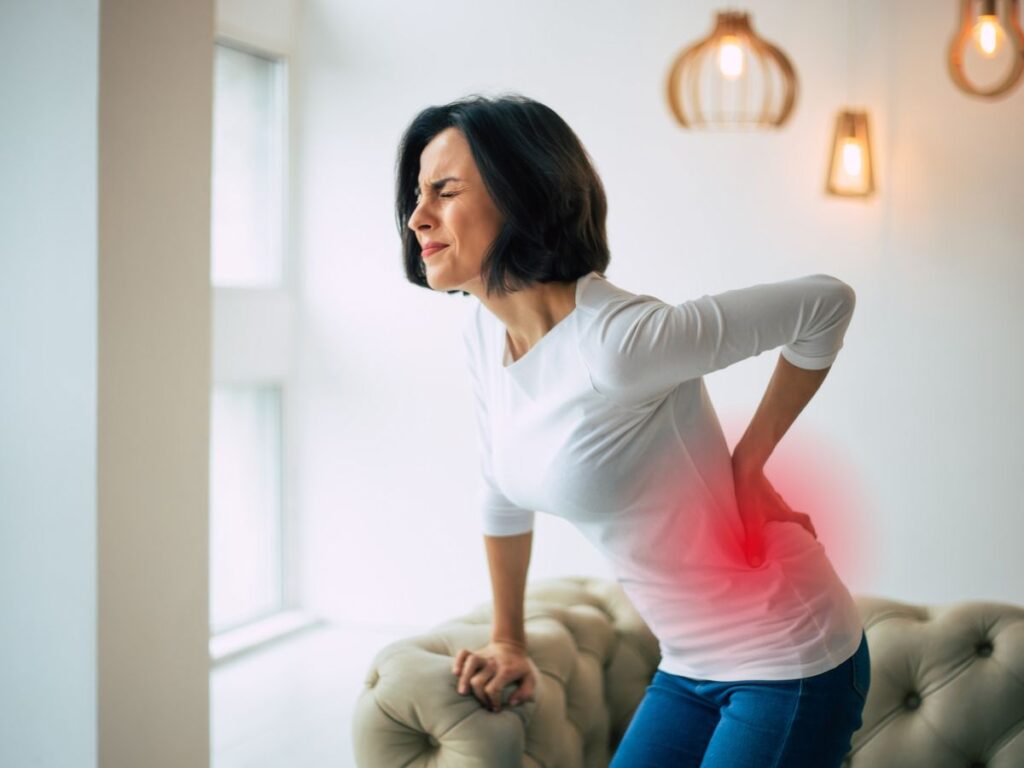
Introduction
Lower back pain is a widespread health problem that affects people worldwide, and women, in particular, often find themselves grappling with this discomfort. According to the American Physical Therapy Association, women have double the likelihood of experiencing lower back pain as men.
In this blog, we will delve into lower back pain in women, exploring its causes, prevalence, and effective treatments.
What is lower back pain?
Lower back pain is any pain that occurs in the lower part of the back, from the base of the spine to the buttocks. It may manifest as a sharp or dull sensation and can be either constant or intermittent. Lower back pain varies in intensity, ranging from mild to severe.
How common is lower back pain in women?
Lower back pain is a ubiquitous companion in many women’s lives, making it a common ailment. Research suggests that lower back pain affects women at a slightly higher rate than men. Approximately 33% of adult women encounter symptoms of lower back pain, whereas the corresponding figure for the adult male population is 25%.
A substantial portion of the female population, regardless of age or background, experiences lower back pain at some point in their lives. It’s a shared experience among many, but the severity and frequency of lower back pain, including pelvic pain, in the lumbar spine can vary widely from person to person. So, while it’s a common challenge, the exact prevalence and impact can differ for each woman.
What causes lower back pain in females?
There are many reasons for lower back pain in women. Some of the most common causes include:
- Menstrual cramps: These cramps occur due to the contraction of the uterus during menstruation. They can vary from mild discomfort to intense pain and may last a few hours or up to a few days. Engaging in regular physical activity has been known to alleviate these symptoms for some individuals.
- Pregnancy: The increasing weight of the growing fetus can exert pressure on the lower back, causing musculoskeletal pain, particularly in the later stages of pregnancy. This is commonly referred to as pain during pregnancy, and it’s a shared experience among many women
- Labor and delivery: The process of labor and delivery can place significant stress on the lower back, particularly on the sacroiliac joint, which is a common cause of pain for pregnant women. Understanding the risk factors associated with this stress is crucial for effective management.
- Endometriosis: This condition, called endometriosis, occurs when endometrial tissue grows outside the uterus, leading to acute pain, particularly in females. Common symptoms include painful periods and discomfort in the lower back, pelvis, and abdomen
- Fibroids: These non-cancerous growths in the uterus, known as fibroids, can cause pain in adult females, specifically in the lower back, pelvis, and abdomen. Diagnosing their presence often involves a thorough physical examination.
- Osteoarthritis: This type of arthritis, caused by the wear and tear of the joints, can impact any joint in the body, including the spine, and is commonly observed in postmenopausal women. Engaging in activities such as lifting heavy objects can exacerbate symptoms and contribute to joint discomfort.
- Scoliosis: This condition, characterized by a curvature of the spine, can cause pain in females, particularly in the lower back. Additionally, it may lead to other issues, such as muscle spasms and nerve pain, often associated with changes in the vertebral body and cervical spine.
What are the best treatments for lower back pain in women?
Low back pain (LBP) stands as the primary cause of disability globally, representing the condition with the highest potential for people, especially in the adult population, to benefit from rehabilitation.
Treatment for lower back pain in women depends on the underlying cause. Options may include:
Physical Therapy
Targeted exercises: Physical therapists can design an exercise program specifically to strengthen the core and back muscles, providing better support to the lower back.
Stretching routines: Specific stretches, as indicated by findings in prospective studies, can improve flexibility and alleviate tension in the lower back.
Medication
Pain relievers: Over-the-counter pain medications like ibuprofen or acetaminophen can help manage pain effectively and reduce inflammation.
Muscle relaxants: Prescribed muscle relaxants may be recommended to ease muscle spasms contributing to non-specific low back pain.
Surgical Intervention
Invasive procedures: In severe cases where non-invasive treatments prove ineffective, surgical options or interventions such as spinal manipulation may be considered, particularly for addressing persistent joint pain.
Surgical procedures: This can include procedures to address herniated discs, spinal stenosis, or other structural issues contributing to lower back pain.
Heat and Cold Therapy
Application of heat packs: Heat therapy, using a heating pad or indulging in a warm bath, can increase blood flow, relax muscles, and provide relief from lower back pain.
Cold compresses: Ice packs, a form of cold therapy, help reduce inflammation and numb the area, offering temporary pain relief.
Lifestyle Modifications
Ergonomic adjustments: Modifying workstations and chairs to support proper posture can prevent and alleviate lower back pain.
Weight management: Maintaining a healthy weight reduces the stress on the lower back and minimizes the risk of developing chronic pain.
Mind-Body Techniques
Yoga and meditation: These practices help manage stress, improve flexibility, and promote overall well-being, potentially reducing lower back pain.
Mindfulness-based stress reduction (MBSR): Techniques focused on mindfulness may assist in coping with chronic pain.
Injection Therapies
Epidural steroid injections: These injections can provide temporary relief by reducing inflammation around irritated nerves in the spine.
Facet joint injections: Targeting specific joints in the spine, these injections can alleviate pain and inflammation.
What are the best ways to prevent lower back pain?
Educating women about these preventive measures empowers them to take proactive steps in lessening the risk of developing lower back pain and promoting long-term spinal health.
Regular Exercise: Incorporate core-strengthening exercises and cardiovascular activities into your routine.
Practice Good Posture: Be mindful of ergonomic practices during daily activities to lessen stress on the lower back.
Avoid Prolonged Inactivity: Take regular breaks, change positions, and incorporate movement into your day to prevent stiffness.
Stress Management: Utilize mind-body practices and ensure adequate sleep to manage stress and reduce the risk of muscle tension and lower back pain.
What are some tips for managing lower back pain at home?
In 2020, low back pain (LBP) affected 619 million individuals globally, and projections indicate a rise to 843 million cases by 2050. This surge is primarily attributed to population growth and aging trends.
Amidst these numbers, home management of lower back pain becomes crucial. Simple yet effective strategies, such as applying heat or cold packs, engaging in gentle stretching exercises, and maintaining a healthy sleep posture, can play a pivotal role. However, it is essential to consult with a healthcare professional before attempting home remedies to ensure their appropriateness for individual cases.
For other information, consult Wild Hawk Physical Therapy
If you’re seeking personalized advice and comprehensive information on managing lower back pain in women, Wild Hawk Physical Therapy is a valuable resource. Our experienced professionals can provide tailored guidance to address specific concerns.
Conclusion
Lower back pain is a common issue that significantly affects many women, impacting their daily lives and overall well-being, especially lower back pain women. Understanding the causes, seeking appropriate treatments, and adopting preventive measures are crucial in managing and alleviating this discomfort
By taking a proactive approach, women can enhance their quality of life and promote long-term health. If you’re experiencing persistent lower back pain, consult healthcare professionals for personalized guidance and support.








